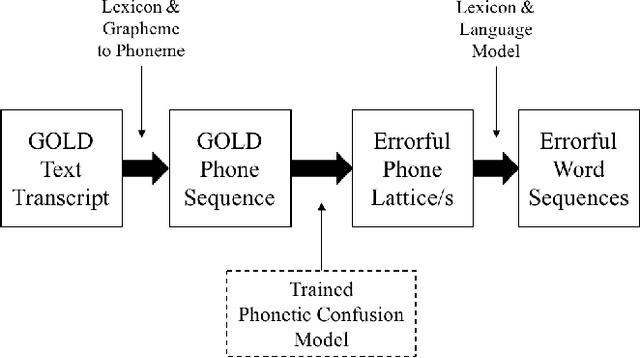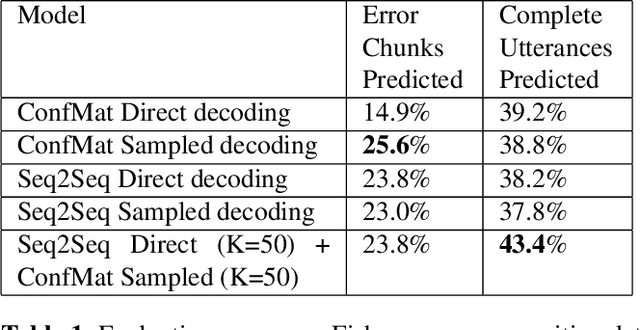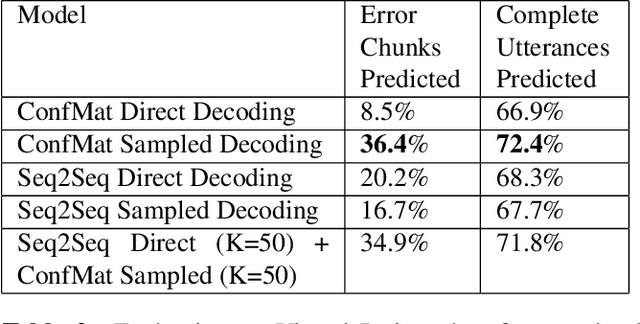Eric Fosler-Lussier
VISTA Score: Verification In Sequential Turn-based Assessment
Oct 30, 2025Abstract:Hallucination--defined here as generating statements unsupported or contradicted by available evidence or conversational context--remains a major obstacle to deploying conversational AI systems in settings that demand factual reliability. Existing metrics either evaluate isolated responses or treat unverifiable content as errors, limiting their use for multi-turn dialogue. We introduce VISTA (Verification In Sequential Turn-based Assessment), a framework for evaluating conversational factuality through claim-level verification and sequential consistency tracking. VISTA decomposes each assistant turn into atomic factual claims, verifies them against trusted sources and dialogue history, and categorizes unverifiable statements (subjective, contradicted, lacking evidence, or abstaining). Across eight large language models and four dialogue factuality benchmarks (AIS, BEGIN, FAITHDIAL, and FADE), VISTA substantially improves hallucination detection over FACTSCORE and LLM-as-Judge baselines. Human evaluation confirms that VISTA's decomposition improves annotator agreement and reveals inconsistencies in existing benchmarks. By modeling factuality as a dynamic property of conversation, VISTA offers a more transparent, human-aligned measure of truthfulness in dialogue systems.
Improving Neural Diarization through Speaker Attribute Attractors and Local Dependency Modeling
Jun 05, 2025Abstract:In recent years, end-to-end approaches have made notable progress in addressing the challenge of speaker diarization, which involves segmenting and identifying speakers in multi-talker recordings. One such approach, Encoder-Decoder Attractors (EDA), has been proposed to handle variable speaker counts as well as better guide the network during training. In this study, we extend the attractor paradigm by moving beyond direct speaker modeling and instead focus on representing more detailed `speaker attributes' through a multi-stage process of intermediate representations. Additionally, we enhance the architecture by replacing transformers with conformers, a convolution-augmented transformer, to model local dependencies. Experiments demonstrate improved diarization performance on the CALLHOME dataset.
RedTeamCUA: Realistic Adversarial Testing of Computer-Use Agents in Hybrid Web-OS Environments
May 28, 2025Abstract:Computer-use agents (CUAs) promise to automate complex tasks across operating systems (OS) and the web, but remain vulnerable to indirect prompt injection. Current evaluations of this threat either lack support realistic but controlled environments or ignore hybrid web-OS attack scenarios involving both interfaces. To address this, we propose RedTeamCUA, an adversarial testing framework featuring a novel hybrid sandbox that integrates a VM-based OS environment with Docker-based web platforms. Our sandbox supports key features tailored for red teaming, such as flexible adversarial scenario configuration, and a setting that decouples adversarial evaluation from navigational limitations of CUAs by initializing tests directly at the point of an adversarial injection. Using RedTeamCUA, we develop RTC-Bench, a comprehensive benchmark with 864 examples that investigate realistic, hybrid web-OS attack scenarios and fundamental security vulnerabilities. Benchmarking current frontier CUAs identifies significant vulnerabilities: Claude 3.7 Sonnet | CUA demonstrates an ASR of 42.9%, while Operator, the most secure CUA evaluated, still exhibits an ASR of 7.6%. Notably, CUAs often attempt to execute adversarial tasks with an Attempt Rate as high as 92.5%, although failing to complete them due to capability limitations. Nevertheless, we observe concerning ASRs of up to 50% in realistic end-to-end settings, with the recently released frontier Claude 4 Opus | CUA showing an alarming ASR of 48%, demonstrating that indirect prompt injection presents tangible risks for even advanced CUAs despite their capabilities and safeguards. Overall, RedTeamCUA provides an essential framework for advancing realistic, controlled, and systematic analysis of CUA vulnerabilities, highlighting the urgent need for robust defenses to indirect prompt injection prior to real-world deployment.
A Non-autoregressive Model for Joint STT and TTS
Jan 15, 2025Abstract:In this paper, we take a step towards jointly modeling automatic speech recognition (STT) and speech synthesis (TTS) in a fully non-autoregressive way. We develop a novel multimodal framework capable of handling the speech and text modalities as input either individually or together. The proposed model can also be trained with unpaired speech or text data owing to its multimodal nature. We further propose an iterative refinement strategy to improve the STT and TTS performance of our model such that the partial hypothesis at the output can be fed back to the input of our model, thus iteratively improving both STT and TTS predictions. We show that our joint model can effectively perform both STT and TTS tasks, outperforming the STT-specific baseline in all tasks and performing competitively with the TTS-specific baseline across a wide range of evaluation metrics.
Improving Transducer-Based Spoken Language Understanding with Self-Conditioned CTC and Knowledge Transfer
Jan 03, 2025Abstract:In this paper, we propose to improve end-to-end (E2E) spoken language understand (SLU) in an RNN transducer model (RNN-T) by incorporating a joint self-conditioned CTC automatic speech recognition (ASR) objective. Our proposed model is akin to an E2E differentiable cascaded model which performs ASR and SLU sequentially and we ensure that the SLU task is conditioned on the ASR task by having CTC self conditioning. This novel joint modeling of ASR and SLU improves SLU performance significantly over just using SLU optimization. We further improve the performance by aligning the acoustic embeddings of this model with the semantically richer BERT model. Our proposed knowledge transfer strategy makes use of a bag-of-entity prediction layer on the aligned embeddings and the output of this is used to condition the RNN-T based SLU decoding. These techniques show significant improvement over several strong baselines and can perform at par with large models like Whisper with significantly fewer parameters.
Improving Speech Recognition Error Prediction for Modern and Off-the-shelf Speech Recognizers
Aug 21, 2024


Abstract:Modeling the errors of a speech recognizer can help simulate errorful recognized speech data from plain text, which has proven useful for tasks like discriminative language modeling, improving robustness of NLP systems, where limited or even no audio data is available at train time. Previous work typically considered replicating behavior of GMM-HMM based systems, but the behavior of more modern posterior-based neural network acoustic models is not the same and requires adjustments to the error prediction model. In this work, we extend a prior phonetic confusion based model for predicting speech recognition errors in two ways: first, we introduce a sampling-based paradigm that better simulates the behavior of a posterior-based acoustic model. Second, we investigate replacing the confusion matrix with a sequence-to-sequence model in order to introduce context dependency into the prediction. We evaluate the error predictors in two ways: first by predicting the errors made by a Switchboard ASR system on unseen data (Fisher), and then using that same predictor to estimate the behavior of an unrelated cloud-based ASR system on a novel task. Sampling greatly improves predictive accuracy within a 100-guess paradigm, while the sequence model performs similarly to the confusion matrix.
A Multi-Aspect Framework for Counter Narrative Evaluation using Large Language Models
Feb 18, 2024



Abstract:Counter narratives - informed responses to hate speech contexts designed to refute hateful claims and de-escalate encounters - have emerged as an effective hate speech intervention strategy. While previous work has proposed automatic counter narrative generation methods to aid manual interventions, the evaluation of these approaches remains underdeveloped. Previous automatic metrics for counter narrative evaluation lack alignment with human judgment as they rely on superficial reference comparisons instead of incorporating key aspects of counter narrative quality as evaluation criteria. To address prior evaluation limitations, we propose a novel evaluation framework prompting LLMs to provide scores and feedback for generated counter narrative candidates using 5 defined aspects derived from guidelines from counter narrative specialized NGOs. We found that LLM evaluators achieve strong alignment to human-annotated scores and feedback and outperform alternative metrics, indicating their potential as multi-aspect, reference-free and interpretable evaluators for counter narrative evaluation.
End-to-End real time tracking of children's reading with pointer network
Oct 17, 2023Abstract:In this work, we explore how a real time reading tracker can be built efficiently for children's voices. While previously proposed reading trackers focused on ASR-based cascaded approaches, we propose a fully end-to-end model making it less prone to lags in voice tracking. We employ a pointer network that directly learns to predict positions in the ground truth text conditioned on the streaming speech. To train this pointer network, we generate ground truth training signals by using forced alignment between the read speech and the text being read on the training set. Exploring different forced alignment models, we find a neural attention based model is at least as close in alignment accuracy to the Montreal Forced Aligner, but surprisingly is a better training signal for the pointer network. Our results are reported on one adult speech data (TIMIT) and two children's speech datasets (CMU Kids and Reading Races). Our best model can accurately track adult speech with 87.8% accuracy and the much harder and disfluent children's speech with 77.1% accuracy on CMU Kids data and a 65.3% accuracy on the Reading Races dataset.
Selective Demonstrations for Cross-domain Text-to-SQL
Oct 10, 2023Abstract:Large language models (LLMs) with in-context learning have demonstrated impressive generalization capabilities in the cross-domain text-to-SQL task, without the use of in-domain annotations. However, incorporating in-domain demonstration examples has been found to greatly enhance LLMs' performance. In this paper, we delve into the key factors within in-domain examples that contribute to the improvement and explore whether we can harness these benefits without relying on in-domain annotations. Based on our findings, we propose a demonstration selection framework ODIS which utilizes both out-of-domain examples and synthetically generated in-domain examples to construct demonstrations. By retrieving demonstrations from hybrid sources, ODIS leverages the advantages of both, showcasing its effectiveness compared to baseline methods that rely on a single data source. Furthermore, ODIS outperforms state-of-the-art approaches on two cross-domain text-to-SQL datasets, with improvements of 1.1 and 11.8 points in execution accuracy, respectively.
How to Prompt LLMs for Text-to-SQL: A Study in Zero-shot, Single-domain, and Cross-domain Settings
May 23, 2023Abstract:Large language models (LLMs) with in-context learning have demonstrated remarkable capability in the text-to-SQL task. Previous research has prompted LLMs with various demonstration-retrieval strategies and intermediate reasoning steps to enhance the performance of LLMs. However, those works often employ varied strategies when constructing the prompt text for text-to-SQL inputs, such as databases and demonstration examples. This leads to a lack of comparability in both the prompt constructions and their primary contributions. Furthermore, selecting an effective prompt construction has emerged as a persistent problem for future research. To address this limitation, we comprehensively investigate the impact of prompt constructions across various settings and provide insights for future work.
 Add to Chrome
Add to Chrome Add to Firefox
Add to Firefox Add to Edge
Add to Edge